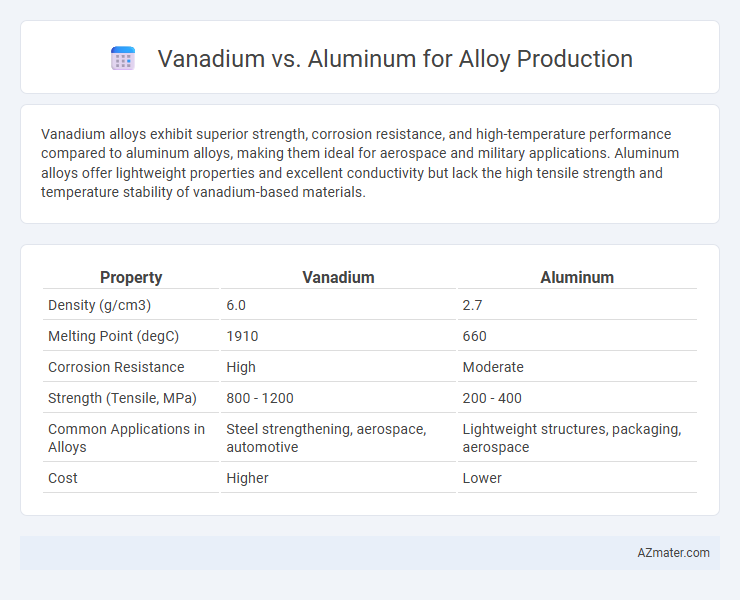Vanadium alloys exhibit superior strength, corrosion resistance, and high-temperature performance compared to aluminum alloys, making them ideal for aerospace and military applications. Aluminum alloys offer lightweight properties and excellent conductivity but lack the high tensile strength and temperature stability of vanadium-based materials.
Table of Comparison
| Property | Vanadium | Aluminum |
|---|---|---|
| Density (g/cm3) | 6.0 | 2.7 |
| Melting Point (degC) | 1910 | 660 |
| Corrosion Resistance | High | Moderate |
| Strength (Tensile, MPa) | 800 - 1200 | 200 - 400 |
| Common Applications in Alloys | Steel strengthening, aerospace, automotive | Lightweight structures, packaging, aerospace |
| Cost | Higher | Lower |
Introduction to Alloying Elements: Vanadium and Aluminum
Vanadium and aluminum are critical alloying elements that enhance the mechanical properties and corrosion resistance of metal alloys. Vanadium improves strength, toughness, and fatigue resistance primarily in steel and titanium alloys, while aluminum contributes to lightweight strength and corrosion protection in aluminum-based alloys. Their distinct atomic structures and properties tailor them for specific industrial applications, making their selection pivotal in alloy design.
Chemical Properties: Vanadium vs Aluminum
Vanadium exhibits superior corrosion resistance and higher melting point (1910degC) compared to aluminum (660degC), enhancing alloy stability at elevated temperatures. Its multiple oxidation states (+2 to +5) allow for diverse chemical reactivity, whereas aluminum primarily forms a stable +3 oxidation state, contributing to its lightweight and non-toxic characteristics. Vanadium alloys offer improved hardness and tensile strength due to their ability to form strong carbide and nitride phases, unlike aluminum alloys which emphasize low density and good conductivity.
Mechanical Strength and Durability Comparison
Vanadium significantly enhances the mechanical strength and durability of alloys by increasing tensile strength, fatigue resistance, and corrosion resistance compared to aluminum alloys. Aluminum alloys, while lightweight and corrosion-resistant, generally offer lower tensile strength and fatigue life than vanadium-enhanced alloys, making vanadium alloys preferred for high-stress, high-performance applications. The incorporation of vanadium in alloy steel improves hardness and toughness, thereby extending component lifespan in demanding environments.
Corrosion Resistance in Alloys
Vanadium enhances corrosion resistance in alloys by forming stable oxide layers that protect metals in harsh environments, outperforming aluminum in maintaining structural integrity under stress. Aluminum alloys offer lightweight advantages and moderate corrosion resistance through natural oxide films but often require additional treatments to match vanadium's durability in aggressive conditions. For applications demanding high corrosion resistance, such as aerospace and chemical processing, vanadium-alloyed metals provide superior performance compared to aluminum-based alloys.
Weight and Density Considerations
Vanadium alloys offer superior strength-to-weight ratios compared to aluminum alloys, making them ideal for high-performance applications where weight reduction is critical. Vanadium's density is approximately 6.0 g/cm3, significantly higher than aluminum's density of about 2.7 g/cm3, which influences the overall mass of alloy components. Choosing between vanadium and aluminum alloys depends on balancing the need for lightweight structures with mechanical strength requirements in aerospace and automotive engineering.
Thermal Stability and Conductivity
Vanadium alloys exhibit superior thermal stability compared to aluminum alloys, maintaining mechanical strength at temperatures exceeding 600degC, which makes them ideal for high-temperature aerospace and industrial applications. Aluminum alloys offer excellent thermal conductivity around 205 W/m*K, significantly higher than vanadium's approximately 30 W/m*K, enhancing heat dissipation in electronic and automotive components. The choice between vanadium and aluminum alloys hinges on balancing high-temperature performance with efficient thermal conduction requirements in alloy production.
Cost and Availability of Vanadium and Aluminum
Vanadium is relatively scarce and more expensive than aluminum, with prices often driven by its limited supply from select mining regions like South Africa and China. Aluminum, abundant and widely produced through well-established extraction processes from bauxite, offers a lower-cost alternative with consistent availability worldwide. The cost-effectiveness of aluminum makes it preferable for large-scale alloy production, whereas vanadium is typically reserved for high-strength, specialized applications despite its higher price and variable availability.
Environmental Impact in Alloy Production
Vanadium alloys offer significant environmental advantages over aluminum alloys in alloy production due to their higher strength-to-weight ratio, reducing material usage and energy consumption during manufacturing. Vanadium extraction and processing typically generate lower greenhouse gas emissions compared to the energy-intensive electrolysis process required for aluminum production. The recyclability of vanadium alloys also contributes to a smaller carbon footprint, promoting sustainable alloy production with reduced environmental impact.
Industrial Applications: Choosing the Right Alloy
Vanadium alloys offer exceptional strength, wear resistance, and high-temperature stability, making them ideal for aerospace, automotive, and tool manufacturing industries. Aluminum alloys provide lightweight properties, corrosion resistance, and excellent machinability, widely utilized in construction, transportation, and packaging sectors. Selecting the right alloy depends on balancing performance requirements, cost efficiency, and environmental conditions in specific industrial applications.
Future Trends in Alloy Development
Vanadium's superior strength-to-weight ratio and corrosion resistance positions it as a critical element in next-generation aerospace and automotive alloys, surpassing traditional aluminum's capabilities in high-performance applications. Emerging research emphasizes nanostructured vanadium-based alloys to enhance mechanical properties and durability under extreme conditions, which aligns with the demand for lightweight yet robust materials. Advances in additive manufacturing techniques further accelerate the integration of vanadium into complex alloy systems, forecasting a shift towards vanadium-dominant alloys in future high-strength, lightweight structural components.

Infographic: Vanadium vs Aluminum for Alloy Production
 azmater.com
azmater.com